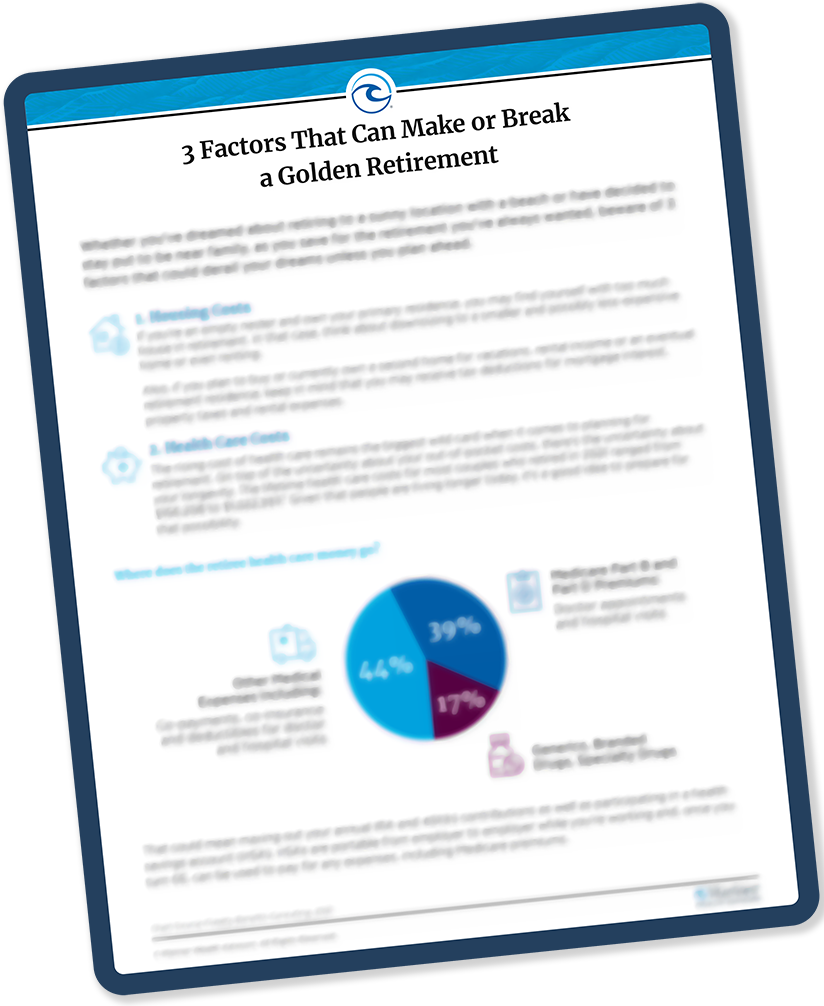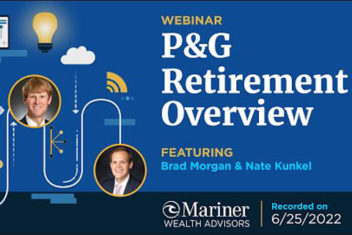Retirement Plan Distribution Choices

Use this guide to narrow your retirement plan choices and options when retiring from P&G based on your age and financial need. Retirees cannot undo a distribution strategy once implemented, so it is important to be informed of the various options and strategies available. Tax bracket, income needs, estate planning considerations, risk tolerance, charitable plans, and many other factors should also be taken into consideration when using this guide.
Terms Used In This Guide
Net Unrealized Appreciation (NUA) Method: This method is available only on P&G stock. P&G has kept track of the cost of the shares in the Plan. The basis in the preferred is as low as $6.84. The basis in the common is as low as $10. Your basis might be higher. Under the NUA method, you have the opportunity to take P&G stock from the Plan and pay tax on the $6.82 or $10.00 rather than the current fair market value. This method is used to distribute a portion of the P&G stock outside of an IRA. Advantages of this include, but are not limited to, preferential dividend treatment and step-up in cost basis for charitable giving.
Substantial Equal Payment Plan (SEPP) (72t): The rule requires you to take the same amount from an IRA every year for five years or until you reach age 59½, whichever is longer. If you set up a SEPP, there is no 10 percent penalty. Three formulas can be used to calculate the amount. After the amount is set, the amount can’t be changed until the SEPP is over. After you reach age 59½ or five years, the plan is over, and you can take any amount out of your IRA without penalty.
Choosing Your P&G Retirement Plan
The strategy you should consider and the options and rules that apply to your P&G retirement plan depend on your age in the year of separation from service. The possibilities are:
- Not age 55 in the year of separation from service
- I will not need money from my retirement assets before age 59½.
- I will need money from my retirement assets before age 59½.
- Age 55 to age 59½ in the year of separation from service
- I will not need money from my retirement assets before age 59½.
- I will need money from my retirement assets before age 59½.
- Age 59½ or older in the year of separation from service
Not Age 55 in the Year of Separation From Service
Will you need money from your retirement assets prior to age 59½? The choices available will be different based on the answer.
Situation: I will not need money from my retirement assets before age 59½.
The problem with needing money before age 59½ is that you will incur a 10 percent penalty on top of the income tax on any distributions you take before age 59½. Thus, if you don’t need access to your retirement account, you do not need to worry about the 10 percent penalty.
- Choice 1: Keep it all in the P&G Plan. The question becomes more of a financial planning question. Are you satisfied with the investment choices provided by the P&G Plan and the requirement of keeping 40 percent invested in P&G stock? Or, do you think you can make better investment choices in an IRA?
- Choice 2: Rollover all or some to an IRA. If you think your money would be better invested outside of the P&G Plan, then you will want to rollover some or all of your retirement account into an IRA that has no requirement to hold 40 percent in P&G stock. Further, you can employ a money manager to give you professional assistance on money management matters. Investment opportunities available in an IRA are unlimited.
If you do decide to rollover money into an IRA, you have these two choices:
- Full IRA rollover: Rollover 100 percent of your retirement plan and savings plan into an IRA. By doing this, you are giving up the ability to take out a block of P&G stock and paying the tax under the NUA method. If you rollover all of your retirement account into an IRA, you cannot take advantage of the NUA method.
- Partial rollover: Rollover some of your retirement plan into an IRA at separation followed by a lump sum distribution of the rest after age 59½.
Example: Assume you have $1,200,000 and you want to take out $200,000 using the NUA method. At the point of separation from service, rollover $1,000,000 onto an IRA and diversify that portion. Then at age 59½, take out the $200,000 in P&G stock under the NUA method.
The fact that you keep $200,000 in P&G stock in the plan doesn’t mean you have to use the NUA method. It simply means you have kept the opportunity open. At or after you reach age 59½, you can decide to either:
- Rollover the entire $200,000 into your IRA.
- Take the whole $200,000 block of stock under the NUA method.
- Do anything in-between (generally a good idea to preserve this opportunity depending on your circumstances).
Situation: I will need money from my retirement assets before age 59½.
To have access to your retirement assets, you will have to pay income tax on any withdrawal at your normal income tax rate and a 10 percent penalty for early withdrawal.
Option 1: Pay the Penalty. Take money as needed and pay the 10 percent penalty which might not be very much.
Example: You need a one-time distribution of $50,000 to pay off your mortgage and the penalty is only $5,000. It might be better to pay the penalty than to set up a substantial equal payment for five years to avoid the penalty.
However, if you need money every year until age 59½, this might not be the best approach.
Option 2: Partial rollover and live on the stock until age 59½.
Example: Assume you have $1,200,000 in your plan and you need $200,000 to get you to age 59½. You would rollover $800,000 into an IRA and take $400,000 out in P&G stock under the NUA method.
You would pay income tax on the cost basis of $6 to $10 per share. Additionally, you only pay the 10 percent penalty on the taxable amount, not the fair market value. If we assume the cost is $10 per share, then you include about $60K in income and the penalty would be only $6K. Even with the penalty, the taxes are very small.
Then you sell P&G stock over the next few years to supplement your budget. You do not touch the IRA until you reach age 59½.
Option 3: Partial rollover and live on the IRA until age 59½.
Example: Assume you have $1,200,000 in your plan. You keep $200,000 in the plan until you reach age 59½ and rollover $1,000,000 into an IRA. You establish a SEPP on the IRA. After you reach age 59½, you could use the NUA method on the $200,000 in the P&G Plan or roll it into your IRA.
Age 55 to Age 59½ in the Year of Separation From Service
Situation: I will not need money from my retirement assets before age 59½.
The problem with needing money before age 59½ is that you will incur a 10 percent penalty on top of the income tax on any distributions you take before age 59½. Thus, if you don’t need access to your retirement account, you do not need to worry about the 10 percent penalty.
- Choice 1: Keep it all in the P&G Plan. The question becomes more of a financial planning question. Are you satisfied with the investment choices provided by the plan and the requirement of keeping 40 percent invested in P&G stock? Or, do you think you can make better investment choices in an IRA?
- Choice 2: Rollover all or some to an IRA. If you think your money would be better invested outside of the P&G Plan, then you will want to rollover some or all of your retirement account into an IRA that has no requirement to hold 40 percent in P&G stock. Further, you can employ a wealth advisor to give you professional assistance on investment decisions. Investment opportunities available in an IRA are unlimited.
If you do decide to rollover money into an IRA, you have these two choices:
- Full IRA rollover: Rollover 100 percent of your retirement plan and savings plan into an IRA. By doing this, you are giving up the ability to take out a block of P&G stock into a taxable account under the NUA method. If you rollover all of your retirement account into an IRA, you cannot take advantage of the NUA method.
- Partial rollover: Rollover some of your retirement plan into an IRA at separation followed by a lump sum distribution of the rest after age 59½. The right strategy depends upon the couple’s earnings, cash flow needs, ages, life expectancy and retirement goals. Minor children are another consideration. If your children are eligible for benefits when you die, when you choose to take Social Security also affects their benefits.
Example: Assume you have $1,200,000 and you want to take out $200,000 using the NUA method. At the point of separation from service, rollover $1M onto an IRA and diversify that portion. Then at age 59½, take out the $200,000 in P&G stock under the NUA method.
The fact that you keep $200,000 in P&G stock in the P&G Plan doesn’t mean you have to use the NUA method. It simply means you have kept the opportunity open. At or after you reach age 59½, you can decide to either:
- Rollover the entire $200,000 into your IRA.
- Take the whole $200,000 block of stock under the NUA method.
- Do anything in-between (generally a good idea to preserve this opportunity depending on your circumstances).
Situation: I will need money from my retirement assets before age 59½.
- Choice 1: Leave it all in the P&G Plan. One advantage with the plan is that you can take out ad hoc distributions during this time frame without a 10 percent penalty. The penalty applies only to IRAs, not profit sharing plans. Under an ad hoc distribution, you may take out any amount without establishing a five year substantial equal payment.
- Choice 2: Partial rollover and live off the P&G Plan. You can use this method even if you want to roll some of your money into an IRA now to start your diversification plan.
Age 59½ or Older in the Year of Separation From Service
You have full access to your retirement account whether it stays in the P&G Plan or is rolled into an IRA. You pay income tax on money as you take it. However, you never need to worry about the 10 percent penalty for early withdrawal. Thus, you face the normal retirement decisions that anybody else faces.
- Do I have enough to retire?
- Do I want to keep it in the plan or roll it into an IRA?
- Do I want to manage the money myself or employ a money manager?
- Do I want to use the NUA method for some of my retirement account?
- How and when do I want to diversify my retirement account?
However, before you take out one dollar after age 59½, you should establish a game plan. After you take any distribution from the plan (other than dividends), you have only that calendar year to take a lump sum distribution and use the NUA method.
Example: You take out $20,000 in 2018. In 2019, you plan to do a lump sum distribution and use the NUA method. You can’t! After you take the first distribution in 2018, that’s the only year that you can use the NUA method. To use the NUA method, all of the account must come out of the P&G Plan in one calendar year.

Don’t Let the Unexpected Derail Your Retirement Goals
When it comes to your golden retirement, don’t leave it up to chance. These 3 major factors could make or break your plans.
The views expressed are for commentary purposes only and do not take into account any individual personal, financial, or tax considerations. It is not intended to be personal legal or investment advice or a solicitation to buy or sell any security or engage in a particular investment strategy.
Mariner Wealth Advisors is not affiliated with Procter & Gamble. Any reference to them should not be construed as an endorsement by either party.
Mariner is the marketing name for the financial services businesses of Mariner Wealth Advisors, LLC and its subsidiaries. Investment advisory services are provided through the brands Mariner Wealth, Mariner Independent, Mariner Institutional, Mariner Ultra, and Mariner Workplace, each of which is a business name of the registered investment advisory entities of Mariner. For additional information about each of the registered investment advisory entities of Mariner, including fees and services, please contact Mariner or refer to each entity’s Form ADV Part 2A, which is available on the Investment Adviser Public Disclosure website. Registration of an investment adviser does not imply a certain level of skill or training.


